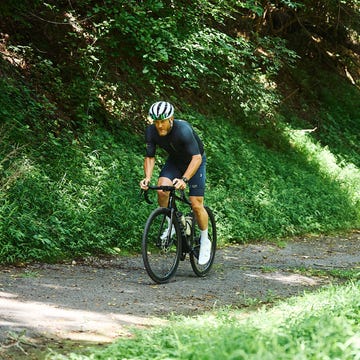The Takeaway: I thought the new SRAM Red 2x12 group was very good when I reviewed it in May. But in this 1x13 XPLR variant for gravel, the group truly shines. Superb comfort and control from the hoods, excellent braking on slippery surfaces, and fast and accurate shifting from a bulletproof rear derailleur. Add in SRAM's user-friendly interoperability of its AXS ecosystem, and this is one of the most impressive component groups I’ve ever ridden.
Jump to:
- This One Goes to 13
- What Makes XPLR Different from Red 2x?
- XPLR Versus Transmission
- New Power Meter Spider with Thread Mount Chainring
- What Parts Does Red XPLR 1x13 Share?
- Is New Red XPLR Backward Compatible?
- What Is Not Compatible?
- Red XPLR 1x for Road and All Road
- How Do You Install a Full Mount Rear Derailleur?
- Weights and Prices
- Review and Impressions
In my review of the refreshed SRAM Red group in May, I noted that new XPLR parts for gravel racing and riding were not part of the mix. I was a bit disappointed, honestly. For months, my industry contacts had hyped me up with details like a 13-speed cassette and Transmission style direct mount (“Full Mount” in SRAM speak) rear derailleur.
Today, SRAM rounds out the new Red group with the debut of the launch of the XPLR parts—13 speed and full mount, as promised—as well as a hugely-wide Zipp 303 XPLR wheelset, and a few other bits.
Below is my full breakdown and ride review on the new Red XPLR group. The key points are 1x only, 13-speed cassette, and direct-mount rear derailleur (requires a frame with SRAM UDH hanger). Those bits aside, the Red XPLR 1x shares much with the new Red 2x12, including brakes, shift/brake levers, and the chain.
Zipp’s 303 XPLR wheels, with their shocking 32mm internal width, are also launching today. My review is here.
This One Goes to 13
Although the new Red 2x launched as a 12-speed drivetrain, SRAM is debuting its first 13-speed drivetrain with XPLR.
The new cassette employs familiar SRAM design and technologies. XDR driver mount, the bulk of the cogs machined from a single piece of steel, with the top 3 cogs made of aluminum. A red ring designates the setup cog—where the chain is placed during derailleur mounting—with SRAM’s sound damping Stealth Rings found between most of the steel cogs.
While 12-speed XPLR cassettes ran a 10-44 (440%) range, the new XPLR 13-speed has a 10-46 (460%) range. Here’s how it breaks down:
13-speed XPLR cassette- 10, 11, 12, 13, 15, 17, 19, 21, 24, 28, 32, 38, 46T
12-speed XPLR cassette- 10, 11, 13, 15, 17, 19, 21, 24, 28, 32, 38, 44T
The 13-speed’s added cog is the 12T between the 11T and 13T, and the 46T replaces the 12-speed’s 44T.
If you’re wondering why XPLR 1x is 13-speed, and Red 2x is 12-speed, it’s because of space. Adding cogs makes a cassette wider, and there’s only so much room between the wheel’s spokes and the dropout. However, because spokes angle away from the hub flange as they reach toward the rim, larger-diameter cogs can sit further inboard than smaller-diameter cogs.
Essentially, the larger 46-tooth gained some space on the inboard side—space not available to a road cassette with smaller cogs—and the Full Mount derailleur design freed up a millimeter on the outboard side. Combined, the added space allowed SRAM to add a 13th cog for more ratio options in the 1x drivetrain.
The important detail is that SRAM added a 13th cog but employs the same cassette driver standard and chain as its 12-speed groups. There are ways to add more cogs within the confines of the current 12x142mm axle spacing standard gravel bikes use, but most likely require new parts—notably, a narrower chain—that aren’t backward compatible with existing drivetrains.
What Makes XPLR Different from Red 2x?
The cassette and rear derailleur parts set XPLR apart from mainline Red. While Red can be configured in either a 2x12 or 1x12 drivetrain employing a 10-28T, 10-30T, 10-33T, or 10-36T cassette, XPLR is exclusively a 1x13 drivetrain that runs a 10-46-tooth cassette.
Previous iterations of XPLR utilized a 12-speed 1x-only rear derailleur attached to a standard derailleur hanger. The new Red XPLR, however, employs SRAM’s Full Mount architecture, which debuted with the Transmission mountain bike drivetrains in March 2023.
With full mount, there is no derailleur hanger between the frame and derailleur. The derailleur mounts directly to the frame, enveloping the inside and outside faces of the drive side dropout and secured by a large diameter bolt that passes through the dropout.
SRAM touts two primary benefits to Full Mount. Strength is one, with SRAM claiming that Full Mount’s unified derailleur/frame/axle interface is as robust as a bottom bracket’s. SRAM debuted the Transmission rear derailleur with images of riders literally standing on the rear derailleur.
With such a robust interface and no derailleur hanger to bend in a crash or other incident, it is extremely unlikely that a Full Mount rear derailleur’s pulley cage will twist into the rear wheel’s spokes, a situation that can break the pulley cage, destroy a rear derailleur, break spokes, and, in extreme cases, break a frame.
Full Mount’s robustness should prevent or greatly reduce situations like we saw at Unbound 2023 when many riders’ races were ruined early due to mud gumming up the rear derailleur, causing a domino effect of derailleur, wheel, and frame failures.
The other primary benefit is more precise derailleur and cassette positioning. The derailleur mount is centered on the rear axle, and the cassette’s lateral position is fixed. SRAM knows exactly where the derailleur and cassette will be located regardless of the frame and wheel a rider uses. This, SRAM claims, allows it to dial in more precise shifting. It can also eliminate the B-gap and high and low limit screws, which primarily serve to allow some adjustment of the rear derailleur to compensate for frame tolerance differences.
However, Full Mount requires a specific dropout design called UDH. Short for Universal Derailleur Hanger, SRAM debuted the standard back in 2019. While a UDH has many advantages on its own—the biggest one being a single hanger that’s compatible with a wide range of bicycles no matter the brand or style—it’s real purpose (and the reason SRAM debuted it years ago and pushed brands to adopt it) was to seed the market with bikes ready to accept the direct mount rear derailleurs that SRAM had in development.
While the standard has seen huge adoption among mountain bikes, it’s not yet as prevalent in the drop bar scene. I suspect that will change as brands roll out new bikes and revise older models. Canyon’s newest Grail is an example of a new model employing the standard, while Specialized recently, and quietly, made a running change and its Crux carbon frames are now UDH equipped. Even a few road models, like Trek’s new Madone and the Ritte Esprit, have UDH.
One more part that is different on XPLR than 2x Red, though less significantly than the derailleur and cassette, is a longer crank axle. This allows frame designers to add tire and mud clearance to their gravel frames. The longer axle increases the chain line to 47.5mm (2mm wider than Red) and increases the Q-factor to 150mm (a 5mm increase).
The XPLR crank uses the same 8-bolt mounting interface as other Red cranks, and the XPLR rings are offered in 38 to 46-tooth sizes. SRAM sells the XPLR crank without a power meter or with a power meter spider that employs Thread Mount chainrings (more on this below).
XPLR Versus Transmission
There are obvious similarities between the Red XPLR and the Transmission rear derailleur, as well as some less obvious ones.
Like Transmission, the Red XPLR rear derailleur requires a UDH-compatible frame and employs many replaceable parts. These include the outer link, battery latch, pulley cage, mounting bolt (AKA B-bolt), clutch, and pulleys.
Another shared feature is how the pulley cage threads on and off the derailleur body without tools. This makes replacement extremely easy.
I found in my testing this feature has another benefit when traveling: When packing a bike into a travel case, I can leave the derailleur and chain installed and rotate the pulley cage up and forward, tucking it safely inside the frame’s rear triangle.
Red XPLR shares its pulleys with the Transmission XX and XX SL derailleurs. This means XPLR uses the Magic Wheel lower pulley, which employs a slipper clutch that allows the pulley teeth to rotate if something jams into the pulley wheel’s inner windows. This should prevent damage and keep the rider moving in the presence of mud and loose sticks.
The XPLR derailleur uses a similar clutch mechanism as Transmission. But for XPLR it is “modified for gravel” (less tension, essentially).
Turning to the differences; there is one very significant distinction between Transmission and XPLR. Transmission is widely regarded for its ability to shift smoothly and precisely (albeit slowly) under huge loads. This is in part to accommodate e-mountain bikes. However, this attribute was not incorporated into XPLR.
JP McCarthy, SRAM’s road product manager, explained that the XPLR cassette does not incorporate X-Sync tooth profiles (Transmission cassettes do), and the XPLR derailleur runs different “cassette mapping” firmware than Transmission units. As a result, XPLR shifts faster than Transmission.
That’s good. But frankly, I don’t believe that drop bar riders—especially racers—would have abided by Transmission’s languid shifting.
And if you’re a drop-bar rider who wants the ability to shift under full pedaling loads, you can mix the Transmission rear derailleur and cassette into a Red 1x AXS drivetrain.
New Power Meter Spider with Thread Mount Chainring
Another idea borrowed from Transmission—in this case, the top-of-the-line XX SL group—is XPLR’s new power meter spider with Thread Mount chainring.
Instead of tabbed chainrings that bolt onto the power spider—or, like some Red power meters, incorporating permanently integrated and non-replaceable rings—XPLR employs a system wherein the ring threads around the outside of the power meter spider.
This format provides the clean look of integrated rings while allowing riders to replace and change sizes more easily and at less cost. It also allows riders to leave the crank installed on the bike when replacing or changing rings. This feature is something racers and mechanics will appreciate if a race day swap is required. But be advised some chainring size changes may require a different length chain.
The only fly in this particular soup is that removing the rings requires a special tool ($65). But in the positive column, the swap process is fast and easy, and no special tools are required to mount a new ring.
The Thread Mount power spider attaches to the Red crank with SRAM's familiar 8-bolt interface. Riders are not locked into the Thread Mount system and can run almost any of SRAM's 8-bolt chainring and power meter options on the Red XPLR crank.
The Thread Mount rings are currently offered in 32, 34, 36, 38, 40, 42, 44, and 46-tooth sizes. Riders who want something larger cannot use the Thread Mount power meter, but there are larger 1x options with power available from SRAM.
What Parts Does Red XPLR 1x13 Share?
While XPLR’s derailleur, cassette, and crank (axle) are distinct, all other parts are shared with Red 2x. Riders use the same AXS controls (including Blip remotes), disc brake parts, Flat Top chains, and AXS batteries.
Riders who want to run a larger chainring than the XPLR 46-tooth on their gravel bike can use Red’s 1x Aero rings if their chosen frame has enough clearance.
Is New Red XPLR Backward Compatible?
One of the best things about SRAM’s AXS ecosystem is its wide-ranging cross-compatibility.
While the Red XPLR rear derailleur and 13-speed cassette must be paired together, riders can mix and match them with parts from Red AXS (first and second generation), Force AXS (first and second generation), Rival AXS and Apex AXS 12-speed groups with few restrictions (though firmware updates may be required). But remember, XPLR requires a 1x chainring for SRAM’s Flat-Top chain.
Red XPLR is also compatible with bits from the SRAM mountain bike product line, including Transmission chains and AXS flat bar controllers.
What Is Not Compatible?
A few parts and frame combinations are incompatible with the new Red XPLR.
The most significant, and probably most obvious, is that it cannot be mounted on a frame that does not employ the UDH standard. SRAM additionally states that Red XPLR can’t be mounted to a frame that has undergone a UDH conversion—it must be a UDH frame from the start.
The XPLR derailleur is designed for a 1x drivetrain only and cannot be combined with a front derailleur. Sorry to crush your 2x13 dreams.
Although there are similarities between the Transmission mountain bike derailleur and cassette and the new XPLR derailleur and cassette, they cannot be mixed. The Transmission rear derailleur can only be paired with the 12-speed 10-52-tooth cassette, and the XPLR rear derailleur can only shift the 13-speed 10-46T cassette.
Some mountain bikers may desire to swap the Transmission for the lighter weight and closer-ratio XPLR 1x13 drivetrain. Sorry to crush your dreams again, but it probably won’t work. It is possible only if the mountain bike you want to use is a hardtail with a 12x142mm rear end. The XPLR derailleur was not designed for a suspension bike’s chainstay growth or Boost (12x148mm) spacing.
Red XPLR 1x for Road and All Road
On Tuesday, two days before Red XPLR’s launch, SRAM sent me an email clarifying the fitment of the XPLR derailleur and cassette for gravel use versus road and all road use.
It read:
To allow for the wider tire clearance that most gravel bikes require, the minimum chainstay length for the XPLR drivetrain system is 415 mm. The XPLR drivetrain system would include the requirement of a UDH dropout and utilizes a wide crank spindle with a 47.5 mm chainline.
For 1x Road and All-Road applications where there is a desire for a wider gear range, the XPLR derailleur and cassette can be paired with a 1x aero crankset with a standard width spindle - but does require the chainstay length between 405mm and 415mm and a frame with a UDH dropout.
Essentially (if you have a short chainstay race bike with UDH), you can mix the Red XPLR 1x13 drivetrain with SRAM’s road-length crank axle to enjoy a 5mm narrower Q-factor.
How Do You Install a Full Mount Rear Derailleur?
If you buy a bike with XPLR already installed, you can skip this part. But if you’re installing Red XPLR yourself, there are a few things to know.
Installing SRAM’s direct-mount rear derailleur is a different process than putting a traditionally mounted derailleur on a bike. But different does not mean harder. In fact, after setting up a few Full-Mount derailleurs, I find it easier than setting up a traditional derailleur.
The most important part of the process is cutting the chain to the proper length. The number of links is determined by the combination of the frame’s chainstay length and the size of the chainring. SRAM offers guides prescribing the proper length in its AXS app (iOS, Android) and within the service section of the website.
After the chain gets cut, the process is straightforward: install the chain, rotate the rear derailleur rearward to take up chain slack, and tighten the derailleur mounting bolt to 35 Newton meters.
I’ve simplified it and left out important details, but that’s the gist of it. The process typically ends there because the rear derailleur requires little to no fine-tuning to fire off accurate shifts. Remember, the full-mount design handles the alignment of the derailleur and cassette.
Weights and Prices
Below are the weights of the Red XPLR 1x13 parts on my scale with MSRPs.
Here are the weights and prices of Shimano’s GRX Di2 2x12. Note that GRX parts are Ultegra and not Dura-Ace level, and Shimano does not yet offer a 1x12 option for its GRX Di2 group. (🕵🏻♂️ I’ve heard rumors a GRX Di2 1x13 wireless group will launch in mid-2025, concurrent with an XTR Di2 1x13 wireless mountain bike group.)
Notes:
- SRAM’s claimed weight for a Red XPLR 1x AXS group—configured slightly differently than the parts I installed on my test bike—is 2,488g (with power meter). This is 70 grams lighter than a Red 2x12 group, 87 grams lighter than a previous generation Red XPLR kit, and 227 grams lighter than Force XPLR, SRAM claims.
- Based on our measured weights of the Red 2x and Red XPLR groups we received for testing, the XPLR group is 58 grams lighter.
- The Red XPLR rear derailleur and cassette combination is about 120 grams lighter than a Transmission XX SL derailleur and cassette combo.
Review and Impressions
SRAM provided me the new Red XPLR parts, which I mounted to an absolutely brilliant Stinner Refugio built with butted titanium tubing. A full review of this bike is forthcoming—but spoiler, I am in love.
As far as the XPLR parts go, I will say it right now: This stuff is great.
Red XPLR builds on the already excellent Red 2x12, brings even more performance, and reveals some benefits I didn’t experience when riding the new Red on the road.
The hoods and ergonomics, already praised for their comfort, are almost a game changer off-road. The hoods are super secure and very confidence-inspiring—they’re an awesome place to hang out on smooth and technical gravel. The additional clearance behind the brake lever is welcome when managing tricky braking from the hoods on rough roads.
The new Red brakes also received accolades, but they’re even more impressive off-road. Their light action and intuitive modulation make controlling speed on rough and slippery surfaces easy.
The braking power and modulation available from the hoods are especially impressive. I love that they allow for a very secure grip on the hoods while braking hard. Cyclocross racers, in particular, will be very pleased with the Red controls and brakes I think,
And what of shifting? It is very, very good. Boarding on exceptional. It’s crisp and quick, quite smooth, and never faltered even when I fired off shifts on rough roads and trails. It does pop, ping, and thunk occasionally—higher load shifts are noisier—but it’s always dead accurate.
This accuracy was present, with zero adjustments, from my first ride on a brand-new drivetrain through the entire testing period (about a month) until today.
And if it’s like my experience with the Transmission mountain bike derailleurs, it will remain perfect for a very long time. Remember, there are no derailleur hangers to bend with Full Mount, so typical crashes and rider tangles should not affect shifting performance in any way. I’ve crashed Transmission bikes heavily on the drive side and scraped and punched derailleurs on rocks while riding. Yet I haven’t needed to do anything but clean and lubricate the drivetrain.
The XPLR Full Mount derailleur is not indestructible. The carbon pulley cage seems like the weakest link, although the chances of it twisting into the spokes are minimal. People will break these things, but doing so is harder than it is with a traditional derailleur and with much less chance of cascading damage to the wheel and frame.
Now, about XPLR shifting under load. SRAM’s Transmission mountain bike parts are the benchmark because you don’t need to ease up on the pedals to shift. It does not require any extra learned shifting technique.
XPLR does not shift like Transmission because SRAM eschewed flawless shifting under load and instead prioritized XPLR’s shifting speed—A decision I heartily co-sign.
Even so, XPLR’s shifting under load is still quite good; minimal shifting technique is required. I only needed to ease off the pedals a touch for the briefest moment, and XPLR willingly performed accurate upshifts and downshifts.
While I walked away feeling that the latest Red 2x12 update was a little underwhelming in a gravel setting, with the new XPLR derailleur and cassette I am excited and amazed by this group. The shifting and braking performance is excellent, the hoods are exceptionally comfortable, and it offers riders many options to mix and match parts—from different price points—to get the features and specs they need. And that ability to mix and match will only get better once SRAM, as it inevitably will, brings the 13-speed cassette, Full Mount derailleur, and updated shift/brake levers to its less expensive Force, Rival, and, perhaps, Apex AXS groups.

A gear editor for his entire career, Matt’s journey to becoming a leading cycling tech journalist started in 1995, and he’s been at it ever since; likely riding more cycling equipment than anyone on the planet along the way. Previous to his time with Bicycling, Matt worked in bike shops as a service manager, mechanic, and sales person. Based in Durango, Colorado, he enjoys riding and testing any and all kinds of bikes, so you’re just as likely to see him on a road bike dressed in Lycra at a Tuesday night worlds ride as you are to find him dressed in a full face helmet and pads riding a bike park on an enduro bike. He doesn’t race often, but he’s game for anything; having entered road races, criteriums, trials competitions, dual slalom, downhill races, enduros, stage races, short track, time trials, and gran fondos. Next up on his to-do list: a multi day bikepacking trip, and an e-bike race.






























